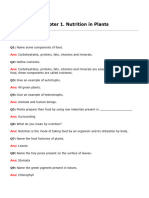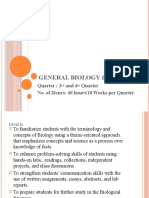TFN p3 Bullets
TFN p3 Bullets
Uploaded by
Riam Carl AgunosCopyright:
Available Formats
TFN p3 Bullets
TFN p3 Bullets
Uploaded by
Riam Carl AgunosOriginal Description:
Original Title
Copyright
Available Formats
Share this document
Did you find this document useful?
Is this content inappropriate?
Copyright:
Available Formats
TFN p3 Bullets
TFN p3 Bullets
Uploaded by
Riam Carl AgunosCopyright:
Available Formats
TFN P3 BULLETS
Oxygen is the most essential of all needs because all body cells require
oxygen for survival.
A developmental task of the older adult family is adjusting to the loss of a
spouse.
By carrying out careful hand-washing and using sterile technique, nurses
provide safety from infection.
Maslow's Hierarchy of basic human needs is useful when planning and
implementing nursing care as it provides a structure for establishing
priorities of care.
Involves the need to be accepted and valued by others; also includes the
need for self-respect
Self-actualization is a need that pertains to what a person's full potential is
and realizing that potential.
The “bad me” grows from experiences of punishment.
Anxiety provoking experiences may create dissociation from self to form
the not me, experiences that are denied.
The good me is a behavior that is rewarded, surpress parts that you don't like and
display good parts.
The Id personality is the source of all drives, instincts, reflexes, needs,
genetic inheritance, and capacity to respond and motivate; the id lacks the
ability to problem solve, is not logical , and operates according to the
pleasure principle.
Develops (in the 4th or 5th month) because the needs, wishes, and
demands of the id cannot be satisfactorily met through primary processes
and reflex action. The ego is the problem solver and reality tester where
"you think through things" (stop and think about it); differentiates subjective
experiences, memory images, and objective reality and attempts to
negotiate a solution.
The anal stage is the second stage of Freud's theory. This is manifested by
moving of the bowels and the fecal retention. Symptoms of fixation include
anal-expulsive personality/anal-retentive personality. Toilet training
(external reality) interferes with gratification received from defecation.
Superego: the moral component of personality. It contains all the moral standards
learned from parents and society. The superego forces the ego to conform not only to
reality but also to its ideals of morality. Hence, the superego causes people to feel
guilty when they go against society's rules. Is the last to develop and represents
the moral component of personality. Helps to choose right from wrong.
Latency stage is a period of sublimation of sex instinct. It is also the period of rest
after previous stage. No developmental events occur.
The child is 16 years old, In the stage of IDENTITY VS. ROLE
CONFUSION. The most significant persons in this group are the PEERS.
Involves learning basic skills and working with others. Function socially
beyond the family..
Autonomy vs. Doubt (Shame) is where the self "ego" appears and is
striving for independence. Toddlers are fond of saying "No". It is a
manifestation of their negativistic behavior.
Peers foster inferiority, say exactly what they think. is expected to be
manifested by children belonging to the industry vs inferiority stage,
Identity vs role confusion happens in adolescence. Gender identity is common at
this stage.
Object permanence is a child's understanding that objects continue to exist
even though he or she cannot see or hear them. It is evident during the
sensorimotor stage.
Object permanence is a child's understanding that objects continue to exist
even though he or she cannot see or hear them. It is one of the most
important accomplishments at the sensorimotor stage.
The pre-operational stage is the third of four stages from Piaget's theory of
cognitive development. It follows the preoperational stage, occurs between
the ages of 7 and 11 years and is characterized by the appropriate use of
logic.
The Formal operational stage is the final stage of cognitive development.
Intelligence is demonstrated through the logical use of symbols related to
abstract concepts.
Prominent until the concrete operational stage, reversibility is the
understanding that numbers and objects can change and then return to
their original state.
You might also like
- Comprehensive Study Guide For NCEDocument73 pagesComprehensive Study Guide For NCEoscarcortina100% (7)
- Chapter 7 Assessing Psychosocial, Cognitive, and Moral Development ConceptDocument5 pagesChapter 7 Assessing Psychosocial, Cognitive, and Moral Development ConceptAnnalisa TellesNo ratings yet
- Theories Related To The Learners' DevelopmentDocument9 pagesTheories Related To The Learners' DevelopmentPrecious AgasaNo ratings yet
- Personality Development: Urwa Naseer Clinical Psychologist Sughra Shafi Medical Complex, NarowalDocument24 pagesPersonality Development: Urwa Naseer Clinical Psychologist Sughra Shafi Medical Complex, NarowalSamia AsgharNo ratings yet
- Dr. Wail S. Araim Associate Prof. Consultant PsychiatristDocument16 pagesDr. Wail S. Araim Associate Prof. Consultant PsychiatristOsama AlhumisiNo ratings yet
- Unit 2 - Developmental TheoriesDocument72 pagesUnit 2 - Developmental Theorieskat suNo ratings yet
- Human Growth & Development Study GuideDocument47 pagesHuman Growth & Development Study Guidevyzze k100% (1)
- Module 4 - Psychological Perspective of The SelfDocument7 pagesModule 4 - Psychological Perspective of The SelfJemuel Bucud Lagarto100% (1)
- Presented By-Jasleen Kaur BrarDocument54 pagesPresented By-Jasleen Kaur BrarRenalyne Andres BannitNo ratings yet
- Lesson 04: Psychological SelfDocument41 pagesLesson 04: Psychological SelfHannah Kathrina MoralloNo ratings yet
- GE 1 Module 4Document12 pagesGE 1 Module 4its03mae14No ratings yet
- (Psych102) Id, Ego and Superego & Ego Defense MechanismsDocument8 pages(Psych102) Id, Ego and Superego & Ego Defense MechanismsFiona Elisse E. MoralesNo ratings yet
- Psychodynamic Theory and TherapyDocument23 pagesPsychodynamic Theory and TherapyWardah IshfaqNo ratings yet
- Sigmund FreudDocument6 pagesSigmund FreudKay ZeeNo ratings yet
- Psychoanalytic Theory: Presented By: Kanika GuleriaDocument38 pagesPsychoanalytic Theory: Presented By: Kanika GuleriaSharanu HolalNo ratings yet
- Personality Assignment 1Document14 pagesPersonality Assignment 1Zohaib TariqNo ratings yet
- Unit 3 - Lesson 2 - Theories of Personalities FileDocument8 pagesUnit 3 - Lesson 2 - Theories of Personalities FileMarian NairamNo ratings yet
- ED204 ReviewerDocument6 pagesED204 Reviewerrheamalacapay28No ratings yet
- Four Theories of Developmental StagesDocument13 pagesFour Theories of Developmental StagesNate LindstromNo ratings yet
- Group Work Human GrowthDocument13 pagesGroup Work Human GrowthemilyNo ratings yet
- Psychological Aspet of Values Education Module WAODocument16 pagesPsychological Aspet of Values Education Module WAOJessebel Loking SerencioNo ratings yet
- Grade 11 Human Development NewDocument68 pagesGrade 11 Human Development NewhatdogNo ratings yet
- Unit 4Document17 pagesUnit 4nicoleeve.abarrientosNo ratings yet
- Stages of DevelopmentDocument14 pagesStages of Developmentstrongman8022No ratings yet
- Transactional Analysis: Group Presentation)Document36 pagesTransactional Analysis: Group Presentation)Saachi MahajanNo ratings yet
- Personal Development ReviewerDocument17 pagesPersonal Development ReviewerDanica TiburcioNo ratings yet
- Sigmund Freud and PsychoanalysisDocument8 pagesSigmund Freud and PsychoanalysisOoi Wan ShengNo ratings yet
- Reaction PaperDocument3 pagesReaction PaperEdlyn Arandia100% (1)
- Psychological PerspectivesDocument6 pagesPsychological PerspectivesKAILAHNo ratings yet
- Freud's Psychoanalytic Theory MODULE 5Document14 pagesFreud's Psychoanalytic Theory MODULE 5vanizabesana1104No ratings yet
- A. Reading 5 (Erikson, Freud)Document7 pagesA. Reading 5 (Erikson, Freud)Ma Portia Jasmin TabogocNo ratings yet
- FreudDocument8 pagesFreudFlordel Catubig MagonciaNo ratings yet
- Personality, Will and CharacterDocument18 pagesPersonality, Will and CharacterSteamNo ratings yet
- PiagetDocument4 pagesPiagetGeraldine WajeNo ratings yet
- Personal DevelopmentDocument6 pagesPersonal DevelopmentKennedy YamilNo ratings yet
- FTC 1 Unit 2Document15 pagesFTC 1 Unit 2Danica AlogNo ratings yet
- FS1 Ep2Document1 pageFS1 Ep2Lester VegaNo ratings yet
- Unit 4 Social and Emotional DevelopmentDocument18 pagesUnit 4 Social and Emotional DevelopmentziramskskNo ratings yet
- Professional Education - Child and Adolescents DevelopmentDocument14 pagesProfessional Education - Child and Adolescents DevelopmentLoina Mae M. DuatNo ratings yet
- Chad Developmental TheoriesDocument13 pagesChad Developmental TheoriesvedramelfeyNo ratings yet
- Chapter 8-2Document18 pagesChapter 8-2api-203814269No ratings yet
- GE 1 ModuleDocument7 pagesGE 1 ModuleJejeboy NambawanNo ratings yet
- Related To The Mental and Emotional State of A PersonDocument13 pagesRelated To The Mental and Emotional State of A PersonSielynNo ratings yet
- Psychoanalytic TherapyDocument28 pagesPsychoanalytic Therapyapi-3704513100% (3)
- Developmental PsychologyDocument13 pagesDevelopmental PsychologyKaykie RMNo ratings yet
- Development TheoriesDocument15 pagesDevelopment TheoriesFalak ChaudharyNo ratings yet
- 4 Psychological Perspective of The Self 1Document4 pages4 Psychological Perspective of The Self 1MicsjadeCastilloNo ratings yet
- Theories of Human Development PerdevDocument27 pagesTheories of Human Development PerdevMerriam Obispo100% (1)
- Theories of Human DevelopmentDocument8 pagesTheories of Human DevelopmentJessel Mae Dacuno100% (1)
- Basic Tenets of Freud's Psychoanalytic Theory: Three Levels of ConsciousnessDocument36 pagesBasic Tenets of Freud's Psychoanalytic Theory: Three Levels of ConsciousnessHarshita SharmaNo ratings yet
- Untitled DocumentDocument11 pagesUntitled Documenttomaag2000No ratings yet
- Chapter Six PersonalityDocument142 pagesChapter Six PersonalityaberaNo ratings yet
- Edu 105 H2Document6 pagesEdu 105 H2Albert OdtujanNo ratings yet
- Module 3.1 - The Child and Adolescent Learners and Learning PrinciplesDocument10 pagesModule 3.1 - The Child and Adolescent Learners and Learning PrinciplesMarkhill Veran TiosanNo ratings yet
- PsychologyDocument139 pagesPsychologydr_nilofervevai2360100% (1)
- Unit II TheoriesDocument6 pagesUnit II Theorieskat suNo ratings yet
- Human Development Essay AP PsychDocument2 pagesHuman Development Essay AP PsychKiley MaloneyNo ratings yet
- Gale Researcher Guide for: Overview of Physical, Cognitive, and Moral Development in PsychologyFrom EverandGale Researcher Guide for: Overview of Physical, Cognitive, and Moral Development in PsychologyNo ratings yet
- Chapter 5 NotesDocument7 pagesChapter 5 NotesNandiniNo ratings yet
- Psychology of Patanjali Yoga Sutras - FinalDocument7 pagesPsychology of Patanjali Yoga Sutras - Finalsmitha.jasti100% (1)
- The Biology and Evolution of Music: A Comparative PerspectiveDocument43 pagesThe Biology and Evolution of Music: A Comparative PerspectiveHoja de ChopoNo ratings yet
- Biochem of Carbohydrates - ReviewerDocument6 pagesBiochem of Carbohydrates - ReviewerEva Marie GaaNo ratings yet
- UACE BIOLOGY PAPER 2 2001 Marking GuideDocument6 pagesUACE BIOLOGY PAPER 2 2001 Marking GuidemwakarickyreaganNo ratings yet
- FDA Letter To 23andmeDocument10 pagesFDA Letter To 23andmeSarahNo ratings yet
- Cas Biology Chapter 30 PQ AnswersDocument3 pagesCas Biology Chapter 30 PQ AnswersMonayem HuqNo ratings yet
- Honeylocusts and Lindens: Gleditsia Triacanthos 'Impcole'Document2 pagesHoneylocusts and Lindens: Gleditsia Triacanthos 'Impcole'jhNo ratings yet
- Sleep Function and Synaptic Homeostasis - Giulio Tononi y Chiara CirelliDocument14 pagesSleep Function and Synaptic Homeostasis - Giulio Tononi y Chiara CirelliGabriela Cristina García FacioNo ratings yet
- Smooth MuscleDocument27 pagesSmooth MuscleMichael GodwinNo ratings yet
- 5 - Amphibians - WeeblyDocument13 pages5 - Amphibians - Weeblyapi-375285021No ratings yet
- CBSE Class 7th Science Value Based Questions Chapter 1 Nutrition in Plants PDF DownloadDocument11 pagesCBSE Class 7th Science Value Based Questions Chapter 1 Nutrition in Plants PDF Downloadpravin161079No ratings yet
- Kunz Et Al. - 1996 - High-pH Anion-Exchange Chromatography With PulsedDocument11 pagesKunz Et Al. - 1996 - High-pH Anion-Exchange Chromatography With PulsedValerie WeinbornNo ratings yet
- Volume 42, Number 21 - November, 2007Document365 pagesVolume 42, Number 21 - November, 2007belleblackNo ratings yet
- Answer Key Whale Evolution From Land To Water Indiana UniversityDocument4 pagesAnswer Key Whale Evolution From Land To Water Indiana UniversityIan Kidd WeaverNo ratings yet
- Plant ProtectionDocument16 pagesPlant ProtectionTimothy BensonNo ratings yet
- Box Jellyfish: Tarlac Christian CollegeDocument7 pagesBox Jellyfish: Tarlac Christian CollegeNaddie DeoreNo ratings yet
- Q3 Summex2 Sci10Document1 pageQ3 Summex2 Sci10Jeff Tristan CaliganNo ratings yet
- Non-Infectious and Infectious Pathological Patterns in Tilapia and Catfish: A Review of The Literature On Causes and Clinical ManifestationsDocument22 pagesNon-Infectious and Infectious Pathological Patterns in Tilapia and Catfish: A Review of The Literature On Causes and Clinical ManifestationsIJAR JOURNALNo ratings yet
- Uncoupling of PARP1 Trapping and Inhibition Using Selective PARP1 DegradationDocument14 pagesUncoupling of PARP1 Trapping and Inhibition Using Selective PARP1 DegradationRachel HeapNo ratings yet
- Drug Pipe LineDocument34 pagesDrug Pipe LineTarun AkhajaNo ratings yet
- Adrenergic DrugsDocument21 pagesAdrenergic DrugsArturo RinconNo ratings yet
- Physicochemical and Functional Properties of Soy Protein Isolate As A Function of Water Activity and StorageDocument9 pagesPhysicochemical and Functional Properties of Soy Protein Isolate As A Function of Water Activity and StoragePaul Jefferson Flores HurtadoNo ratings yet
- Photosynthesis QuestionsDocument23 pagesPhotosynthesis Questionssheenaa100% (1)
- Akash Full Bio PDFDocument82 pagesAkash Full Bio PDFAdvik Sankar100% (2)
- MC 2L Act. 4 Isolation Characterization of Nucleic AcidsDocument5 pagesMC 2L Act. 4 Isolation Characterization of Nucleic AcidsRyan Carlo IbayanNo ratings yet
- General Biology 1 OrientationDocument13 pagesGeneral Biology 1 OrientationJeM LobiLabNo ratings yet
- Sugar CaneDocument10 pagesSugar CaneparfreeNo ratings yet
- PSYC2015 Learning and MotivationDocument43 pagesPSYC2015 Learning and MotivationJasmine FrancisNo ratings yet
























































































